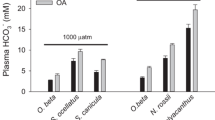Abstract
Temporal responses of eyes from four decapod species taken from sublittoral (Pandalus montagui Leach), coastal [Nephrops norvegicus (L.)] and deep-sea [Paromola cuvieri (Risso) and Chaceon (=Geryon) affinis A. Milne Edwards and Bouvier] habitats were examined. The electroretinogram responses to a range of sinusoidal intensity modulations between 0.5 and 40 Hz were recorded. Recordings were made from individuals adapted successively to two background light intensities. The sublittoral and coastal species showed faster responses when adapted to the higher light level and they also responded best to intermediate frequencies. When adapted to the lower light level, all species responded most strongly to low-frequency stimuli. Physiological and ecological reasons for the differences in responses are suggested.
Similar content being viewed by others
Author information
Authors and Affiliations
Additional information
Received: 2 July 1999 / Accepted: 26 October 1999
Rights and permissions
About this article
Cite this article
Johnson, M., Shelton, P. & Gaten, E. Temporal resolution in the eyes of marine decapods from coastal and deep-sea habitats. Marine Biology 136, 243–248 (2000). https://doi.org/10.1007/s002270050682
Issue Date:
DOI: https://doi.org/10.1007/s002270050682




